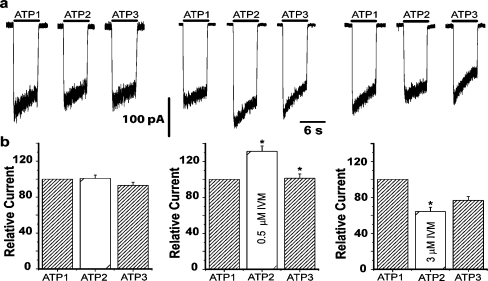Fig. 6.
Effect of ivermectin on ATP-activated currents. a Representative recordings of inward currents evoked by sequential applications of 100 μM ATP for 6 s. The holding potential was −50 mV in all cases. The left panel shows control traces in response to three applications of ATP (ATP1, ATP2, and ATP3), indicating that desensitization of the receptor is removed under these conditions. The middle panel refers to the application of ATP in the presence of 0.5 μM ivermectin (ATP2). There is a clear increase in the current amplitude in relation to control (ATP1) which is reversed upon wash out of IVM. The right panel shows ATP-evoked current before (ATP1) and after incubation with 3 μM IVM. A small decrease in the amplitude of the ATP-evoked current (ATP2) is now observed, which is partially reversed upon wash out of the drug (ATP3). b Bar graphs of the peak current amplitudes evoked by applications of ATP in control conditions (left panel, n = 17 cells), after incubation with 0.5 μM IVM (middle panel, n = 10 cells), and after incubation with 3 μM IVM (right panel, n = 11 cells). Numbers are normalized to the first control condition taken as 100%. Bars represent mean ± SEM (*p < 0.05, Wilcoxon test). Washout interval between second and third applications was 3 and 5 min, respectively

